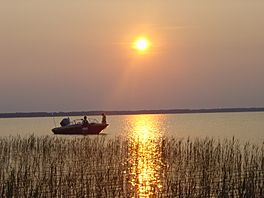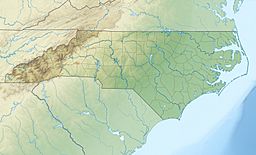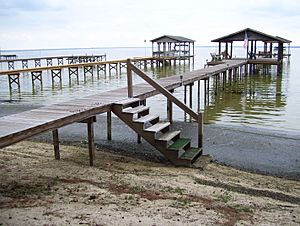Lake Waccamaw facts for kids
Quick facts for kids Lake Waccamaw |
|
|---|---|

Sunset from State Park by Joey Nobles
|
|
| Location | Columbus County, North Carolina |
| Coordinates | 34°17′16″N 78°30′31″W / 34.28778°N 78.50861°W |
| Primary inflows | Big Creek; First Little, Second Little and Third Little Creeks |
| Basin countries | United States |
| Managing agency | North Carolina Division of Parks and Recreation |
| Designation | State Lake |
| Surface area | 8,938 acres (3,617 ha) |
| Average depth | 7.5 ft (2.3 m) |
| Surface elevation | 43 ft (13 m) |
| Settlements | Lake Waccamaw |
Lake Waccamaw is a large freshwater lake located in Columbus County, North Carolina. It is the biggest of the natural Carolina Bay Lakes. These "Bay" Lakes get their name from the many bay trees that grow in the swampy, oval-shaped areas along the Carolina coast.
The lake is fed by four creeks: First, Second, Third, and Big creeks. Water flows out of the lake to form the Waccamaw River. This river then travels southeast to reach the Atlantic Ocean near Georgetown, South Carolina.
Contents
Exploring Lake Waccamaw's Geography
Lake Waccamaw has a wide, flat bottom made of mud and peat. Sandy areas and underwater sandy terraces surround it. These sandy parts can stretch up to 500 meters (about 1,640 feet) from the shore.
The lake is shaped like an oval. It is about 5.2 miles (8.4 km) long and 3.5 miles (5.6 km) wide. It covers an area of about 8,938 acres (3,617 hectares). The lake's average depth is 7.5 feet (2.3 meters), and its shoreline is about 14 miles (23 km) long. Most of the lake's bottom (about 70%) is clear sand. The middle part (about 30%) is covered with a layer of fibrous peat.
Discovering Lake Waccamaw's Natural History
Scientists believe Lake Waccamaw is between 15,000 and 30,000 years old. Underneath the lake are layers of rock containing fossils from different time periods. These include the Goose Creek Limestone and the Waccamaw Formation.
In 2008, a whale fossil was discovered in the lake! Scientists carefully removed the whale bones. They think the whale lived 1 to 3 million years ago. The whale's skull has been put back together. You can see it on display at Lake Waccamaw State Park. It is on loan from the North Carolina Museum of Natural Sciences.
How Lake Waccamaw Gets Its Water
Lake Waccamaw gets most of its water from Big Creek and the surrounding swamps. The decaying plants in the swamps make the water a tea-like color. Unlike most other Carolina Bay lakes, Lake Waccamaw relies more on swamp water than direct rain.
A limestone cliff along the north shore helps filter the water. This filtering reduces the water's acidity, making it a great home for many different kinds of aquatic life.
How Carolina Bays Formed
Lake Waccamaw is one of the largest Carolina Bays. Some people think these bays were formed by meteorites or comets hitting the Earth. However, scientists have not found any proof for this idea.
Instead, dredges have pulled up old, charred tree stumps from the lake. This supports a theory that the lake was formed by a huge prehistoric peat fire. The fire burned a basin into the ground, which then filled with water.
The Human Story of Lake Waccamaw
Before European settlers arrived, Native Americans lived around Lake Waccamaw. There's a place on the east shore still called Indian Mounds. People say nothing will grow on the site of one of these mounds.
Early Settlers and Land Grants
Charles II of England first gave this land to one of the Lord Proprietors. These proprietors then gave smaller pieces of land to people willing to settle in the new world. Over time, these large land grants were divided among families and new settlers.
By the mid-1700s, many of the first settlers had left the lake area. New people, like John Powell, arrived. He brought cattle from Virginia to settle his own land grant.
A Famous Quote and Its Origin
There's a famous quote often said to be from John Bartram: "This is the pleasantest place that I have ever seen." However, this quote isn't found in his actual writings.
The true origin of the quote might come from a trip in 1733. A group of at least 14 men traveled with Nathaniel Moore. They went from old Brunswick up the Cape Fear River to Moore's place, and then to Lake Waccamaw. An unnamed writer from that trip described the lake as "the pleasantest place that ever I saw in my life."
Important Figures and Land Ownership
Absalom Powell, John Powell's son, began buying large areas of land after the American Revolutionary War. A North Carolina Historical Marker was placed near his grave at Lake Waccamaw in 1933.
Another son, Isaac Powell, was appointed the first major for the Bladen County militia in 1804. He also became a Justice of the Peace in 1806. Isaac Powell was the biggest landowner in Columbus County during his time. He owned over 10,000 acres (40 km²) of land, mostly around Lake Waccamaw.
Lake Waccamaw State Park
Lake Waccamaw was made a North Carolina State Lake in 1929. Today, it is managed by the nearby Lake Waccamaw State Park.
Controlling Lake Levels
A natural sand bar runs along the northwest shore. It sits between a cypress swamp and the main lake. In 1946, this sand bar was built up with material dredged to create a nearby canal. Private homes were then built there.
Big Creek brings tea-colored water from the large cypress and gum tree swamp at the lake's northeast corner. The Waccamaw River flows out from the southern shore. A dam was built at the lake's outlet in 1926. This dam now controls the lake's water levels. Before the dam, water levels used to drop a lot during dry periods, sometimes exposing the sandy terraces. The dam was updated in 2008 to help manage the water levels even better.
Lake Waccamaw is also fed by several smaller creeks: First Little, Second Little, and Third Little Creeks. Water from the Friar swamp also flows into the lake. Underground springs feed these creeks.
Recent Environmental Changes
In 2007, a lack of rain in eastern North Carolina caused the water level in Lake Waccamaw to drop. By late 2007, levels were more than 15 inches (380 mm) below normal. The lowest water level ever recorded was 19.5 inches (495 mm) below normal in 1993. The highest was 37 inches (940 mm) above normal in 1999. In 2008, more rain and swamp drainage helped increase the water levels.
In October 2012, an invasive plant called hydrilla began to spread in the lake. Efforts to remove this weed were expected to take 5 to 7 years.
Amazing Aquatic Life in Lake Waccamaw
Lake Waccamaw is home to several unique species that are found nowhere else in the world! These include the Waccamaw darter, silverside, and killifish.
The lake also has many unusual mollusks. Fifteen different kinds of mussels and clams have been found here. Of the 11 snail species, the Waccamaw amnicola and siltsnail are also one-of-a-kind. You can also find alligators living in Lake Waccamaw!
| Species | Family | Habitat | Trophic level | Status |
|---|---|---|---|---|
| Acantharchus pomotis | Centrarchidae | demersal | 3.0 | native |
| Ameiurus catus | Ictaluridae | demersal | 3.8 | native |
| Ameiurus natalis | Ictaluridae | demersal | 3.3 | native |
| Ameiurus platycephalus | Ictaluridae | demersal | 3.4 | native |
| Amia calva | Amiidae | demersal | 3.8 | native |
| Anguilla rostrata | Anguillidae | demersal | 3.7 | native |
| Aphredoderus sayanus | Aphredoderidae | demersal | 3.4 | native |
| Centrarchus macropterus | Centrarchidae | demersal | 3.7 | native |
| Cyprinus carpio carpio | Cyprinidae | benthopelagic | 3.0 | native |
| Dorosoma cepedianum | Clupeidae | pelagic | 2.0 | native |
| Elassoma zonatum | Elassomatidae | demersal | 3.0 | native |
| Enneacanthus gloriosus | Centrarchidae | demersal | 3.0 | native |
| Enneacanthus obesus | Centrarchidae | demersal | 3.0 | native |
| Erimyzon oblongus | Catostomidae | demersal | 2.8 | native |
| Erimyzon sucetta | Catostomidae | demersal | 2.8 | native |
| Esox americanus americanus | Esocidae | demersal | 3.4 | native |
| Esox niger | Esocidae | demersal | 4.0 | native |
| Etheostoma fusiforme | Percidae | benthopelagic | 3.2 | native |
| Etheostoma perlongum | Percidae | benthopelagic | 3.4 | endemic |
| Fundulus waccamensis | Fundulidae | benthopelagic | 3.0 | endemic |
| Gambusia affinis | Poeciliidae | benthopelagic | 3.2 | native |
| Lepisosteus osseus | Lepisosteidae | demersal | 4.2 | native |
| Lepomis auritus | Centrarchidae | demersal | 3.1 | native |
| Lepomis gibbosus | Centrarchidae | benthopelagic | 3.1 | native |
| Lepomis gulosus | Centrarchidae | demersal | 3.7 | native |
| Lepomis macrochirus | Centrarchidae | benthopelagic | 3.3 | native |
| Lepomis punctatus | Centrarchidae | demersal | 3.0 | native |
| Menidia extensa | Atherinidae | pelagic | 3.2 | endemic |
| Micropterus salmoides | Centrarchidae | benthopelagic | 3.8 | native |
| Morone americana | Moronidae | demersal | 3.0 | native |
| Notemigonus crysoleucas | Cyprinidae | demersal | 3.0 | native |
| Notropis chalybaeus | Cyprinidae | benthopelagic | 3.0 | native |
| Notropis petersoni | Cyprinidae | benthopelagic | 3.0 | native |
| Noturus gyrinus | Ictaluridae | demersal | 3.2 | native |
| Perca flavescens | Percidae | benthopelagic | 3.7 | native |
| Pomoxis nigromaculatus | Centrarchidae | benthopelagic | 4.2 | native |
| Umbra pygmaea | Umbridae | demersal | 3.6 | native |
Legends of Lake Waccamaw
There are many stories about how Lake Waccamaw was formed.
The Meteorite Legend
One legend tells of a meteor (a falling star) that hit the Earth on the southeast side of the lake. This meteor destroyed a beautiful flower garden. Warriors had planted these flowers when they returned from hunts or protected their village. The women of the village took care of the garden, and many animals lived there too.
The story says that the people forgot to thank the Creator and became too proud. So, the Creator sent the meteor as a punishment. Even today, the Waccamaw Siouan people remember these stories.
The Princess and the Garden Legend
Another legend is found in the book "Recollections and Records." This story describes the lake's origin as a romantic myth. According to local tradition, the large and beautiful lake was once a mound of flowers.
The keeper of this lovely garden was an American Indian princess. She was known as the most beautiful princess in the world. Each spring, it was a custom for the chiefs of all tribes to send their sons to the princess's camp. There, she would give them a blessing and a wild rose for good luck.
The tale continues: a young brave who had seen the princess asked her to be his wife. She replied that she had promised never to marry. She wanted to stay in the garden, teach, and send blessings to all the tribes. The brave became very angry and swore he would destroy the flower mound. His tribe invaded and defeated the Waccamaw braves and their chiefs.
The princess knelt and asked to die in the garden. She also asked that the mound of flowers be changed into a beautiful lake that no one could destroy. She wished that the lake would never dry up and that its waters would always be pure and clear.
Interesting Facts About Lake Waccamaw
The Lake Waccamaw Depot museum is housed in a building from 1904. This building was once an Atlantic Coast Line Railroad depot. It is now listed on the National Register of Historic Places.
The museum has many interesting exhibits, including:
- A 300-year-old Indian canoe.
- Marine fossils found in the lake.
- Natural history specimens.
- Waccamaw Siouan Indian artifacts.
- Items from early European settlers.
- Railroad history, including a caboose.
- Information on local industries like turpentine, cypress shingles, logging, and tool making.
- Many old photographs.
The museum is open on Wednesday, Thursday, and Friday from 10 AM to 3 PM, and on Sundays from 3 PM to 5 PM. Admission is free, and the museum is accessible for people with disabilities.
 Geographic data related to Lake Waccamaw at OpenStreetMap
Geographic data related to Lake Waccamaw at OpenStreetMap




